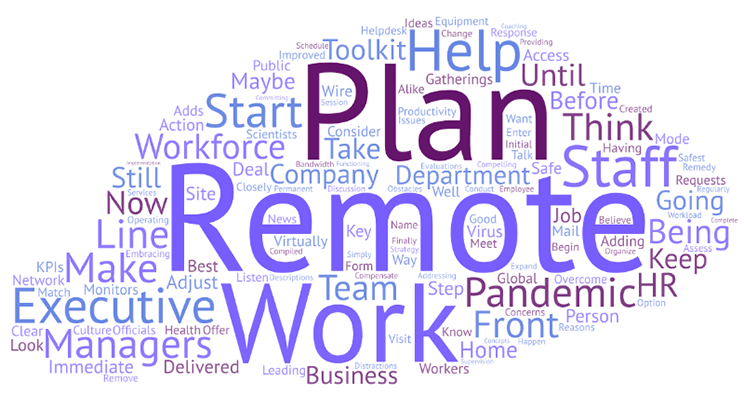Setting up a Remote Workforce: Tribulation or Transformation?
- Details
- Working from Home

"It's almost August and we were hoping to be back in the office soon." This is the thought crossing the minds of business leaders across the USA. I'm sorry to say that progress against the coronavirus has gotten worse instead of better. It's just not safe to assemble in office spaces yet. So what do we do?
Office-based workers have been functioning reasonably well from home with cobbled-together equipment, furniture, and Zoom calls. But I'm hearing more and more about "Zoom fatigue." It's time to start addressing the reality that we're going to be working from home for much longer than we expected. Our work-from-home scenario could last anywhere from 1 to 3 years, depending on when a vaccine might be invented, whether it is effective, and when it will be globally distributed and available. Yes, I said "globally": the United States may have it the worst, but we have to be able to inoculate and protect everyone on the planet.
So if you're tired of just "getting by" with your office-based employees working from home, this is your opportunity to rethink how you work: how your company hires, manages, and leads a workforce that's not in your building. It's time to move from "tribulation" to "transformation."
What Do You Mean by Transformation?
Let's start by imagining the end result.
The day starts at the usual hour, with employees having staggered start times. That allows them to get their children either set up for remote learning or (eventually) get them to the school building for classes. Everyone working remotely knows they have to be available and "visible" online by 9:00 or 9:30 am by logging into the network and signing on to the chat application your company uses.
Meetings are scheduled during core hours -- say 10:00 am to 4:00 pm. Everyone working remotely has a comfortable desk and chair, a laptop or desktop machine, good headphones or earbuds, and a webcam to use during their meetings. Everyone on the meeting knows how to use the meeting software because they watched a 10-minute training video on the features. They also understand the protocols: mute yourself when you're not talking, and be ready to un-mute promptly when necessary.
Employees know what work they have to do for the day because the work they do has been measured and quantified, and is being tracked to completion. Workers use chat, their phones, and/or impromptu online meetings to replace what used to be visits to each others' workstations. Employees know how to write brief and effective emails because they've been trained how to use them to summarize decisions made during those impromptu conversations. Meeting participants take turns keeping notes, and notes are promptly sent out after the meeting. The notes may also be saved to a central cloud storage and/or added to task tracking applications.
Each manager meets with their employees on a regular basis -- preferably weekly -- to track progress and remove obstacles. Managers have had management training, and have clear expectations from their bosses on how to motivate their employees. Executives also have regular meetings with their direct reports, and those conversations are documented and actions tracked. Key Performance Indicators (KPIs) have been re-imagined for remote workers, then documented and shared with employees so that they're clear on what is expected of them.
The Human Resources (HR) department has worked with leaders to re-imagine how to track, educate, and reward employees in this new remote environment. HR has been instructed to consider out-of-area candidates who have the right experience, since nearly everyone is working remotely anyway. Leadership development has been shifted to remote delivery, and opportunities for leadership are clearly defined.
The one thing that has not entered this rosy scenario is the use of spyware for employees. If you set things up the right way, you won't need it. If you develop a culture of caring for your remote workforce, you will receive loyalty in return. Remember the part about having work quantified, measured, and tracked? That's what prevents the need to spy on employees. If the work isn't getting done, you'll know it. Having set up regular and consist contact or meetings with them, you'll know what's going on in their lives and can mitigate it.
This is Not The Impossible Dream
How do I know? Because I've set up systems like this, where everyone works from home, and the work is quantified and tracked. We had core hours, we had regular meetings, and we had an HR department that understood how to hire for remote work. The methodology is still sound, and in fact, we need it more than ever. You can have a remote workforce and be as productive (usually more so) as if you were all together in an office.
Whether your company decides to change to a fully-remote work style going forward, or just wants to cope with our current situation in a more effective and humane way, now is the time to make those changes. It's clear that we're going to have to operate under these conditions for at least another year, probably longer. Turn off the tribulation and embrace transformation.
Want to know how? Visit www.RemoteLeadershipSuccess.com and download a free PDF that will get you started. I invite you also to visit www.AskToolie.com and book a 30-minute strategy session to discuss the ideas here and those found in that 32-page PDF. I'll talk to you soon!

